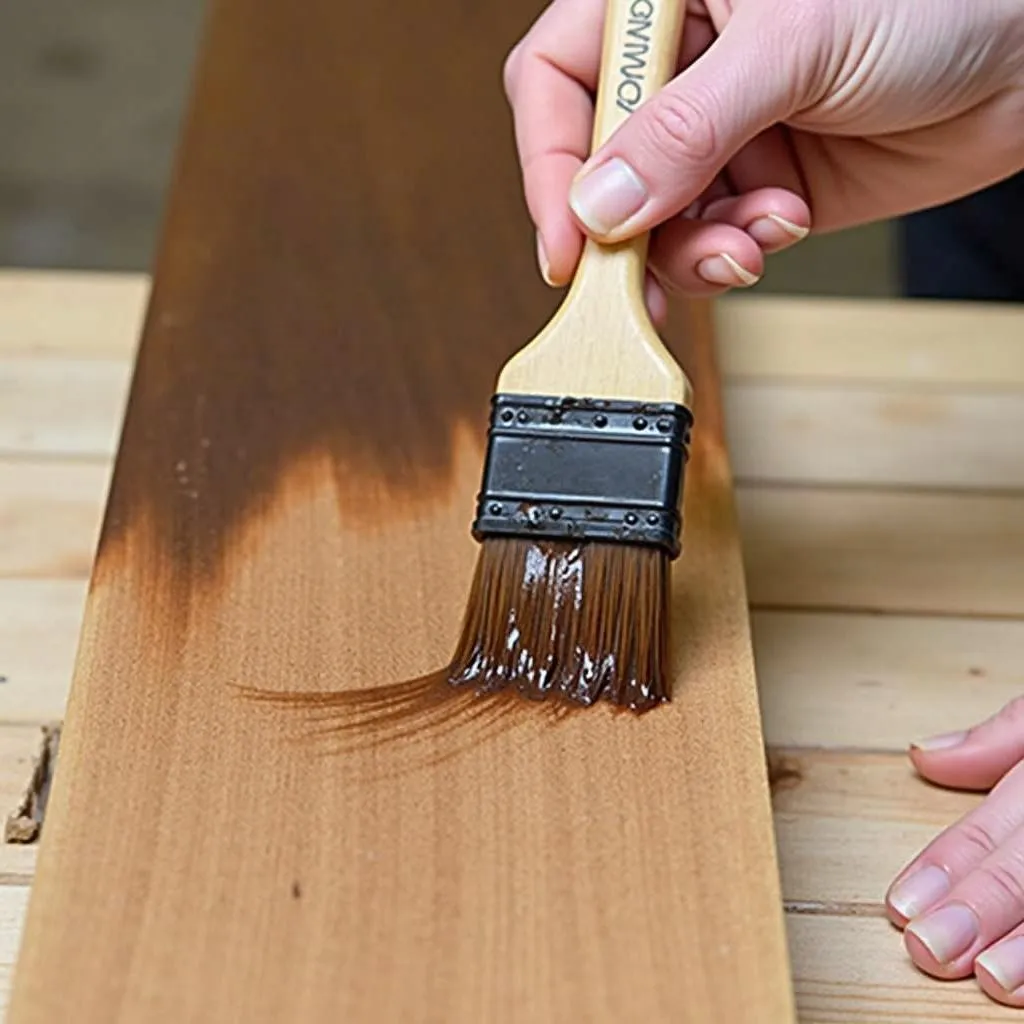Changing the color of wood can dramatically refresh furniture, floors, and even smaller decorative items. Whether you’re aiming for a modern painted look, a rustic weathered finish, or a rich, stained hue, understanding the process is key to achieving the desired outcome.
 Applying wood stain with a brush
Applying wood stain with a brush
Evaluating Your Wood and Desired Outcome
Before diving into the how-to, consider the type of wood you’re working with and your desired effect. Different woods absorb and react to color differently. For instance, hardwoods like oak and maple are known for their ability to take stain well, while softer woods like pine might require pre-treatment for consistent results.
Similarly, your vision plays a crucial role. Are you looking for a complete color transformation with paint, a subtle enhancement with stain, or an aged and weathered look achievable through specific techniques? Identifying these factors will guide you toward the right materials and methods.
Methods for Changing Wood Color
Several techniques can help you achieve the desired wood color transformation. Let’s explore some popular options:
1. Staining: Enhancing Natural Beauty
Wood staining is a classic choice for enriching the natural beauty of wood grain while adding color. It involves applying a pigmented liquid that penetrates the wood fibers.
-
Choosing the Right Stain: Stains come in various shades, from light oak to rich mahogany, allowing you to match your existing décor or create a contrasting element. Oil-based stains offer deeper penetration and durability, while water-based options are known for their faster drying times and lower odor.
-
Applying the Stain: A clean, sanded surface is crucial for even stain absorption. Apply the stain evenly along the wood grain using a brush, rag, or foam applicator. Allow the stain to penetrate for the recommended time before wiping off the excess. Multiple coats can be applied for a richer color.
 Different wood stain colors on samples
Different wood stain colors on samples
2. Painting: A Complete Transformation
Painting offers a way to completely transform the look of your wood, concealing the natural grain and creating a blank canvas for your desired color.
-
Preparing the Surface: Thorough sanding is essential before painting wood. This creates a smooth surface for the paint to adhere to, preventing peeling or chipping later on.
-
Priming for Success: Applying a primer specifically designed for wood is highly recommended. Primers seal the wood, prevent stains from bleeding through, and create a uniform base for the paint to adhere to.
-
Painting Techniques: Use a brush, roller, or spray paint to apply the paint evenly in thin coats. Allow ample drying time between coats to ensure a smooth and durable finish.
3. Other Techniques: Exploring Creative Options
Beyond staining and painting, several creative techniques can be employed to achieve unique wood color effects:
-
Whitewashing: This technique involves applying a diluted white paint or stain, creating a light and airy look that allows the wood grain to peek through.
-
Distressing: Achieve an aged and rustic appearance by intentionally creating scratches, dents, and other imperfections on the wood surface. This technique works well with paint or stain and adds character to furniture and décor.
-
Limewashing: Similar to whitewashing but using a lime-based solution, limewashing results in a chalky, matte finish with a unique depth and texture.
 Wood being painted white
Wood being painted white
Conclusion
Changing the color of wood is an achievable and rewarding way to breathe new life into furniture, update your home décor, or simply experiment with different aesthetics. By understanding the various techniques available, selecting the right materials, and following proper application methods, you can achieve stunning results that reflect your personal style and enhance the beauty of your wooden pieces. Remember, the key is to start with a clear vision, choose the appropriate technique, and execute each step with care.
FAQs
1. Can I stain over painted wood?
While possible, it’s recommended to strip the existing paint completely before staining. This ensures proper stain penetration and a more even finish.
2. What type of paint is best for wood furniture?
Latex-based paints are popular for furniture due to their low odor, easy cleanup, and durability. However, oil-based paints offer a smoother finish and better moisture resistance.
3. How can I lighten wood without stripping it completely?
If you’re working with a light stain or finish, sanding the surface can help lighten the wood. However, for darker stains, a wood bleach might be necessary.
4. How do I prevent brush marks when painting wood?
Using a high-quality brush, applying thin coats, and maintaining a wet edge while painting can help minimize brush marks.
5. Can I change the color of wood without sanding?
While sanding is generally recommended for optimal results, some products, like liquid sanders or deglossers, can help prepare the surface without extensive sanding.
Need More Help?
For personalized guidance on changing the color of your wood or assistance with any other color-related projects, don’t hesitate to contact us. Call us at 0373298888, email us at [email protected], or visit us at 86 Cầu Giấy, Hà Nội. Our team of color experts is available 24/7 to answer your questions and provide expert advice. We’re passionate about helping you create spaces that reflect your unique style and vision.

